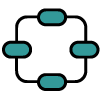VERBUND Innovation Challenge
Applications are now closed!
- Days
- Hours
- Minutes
- Seconds
3
challenges
8k €
equity-free prize money per winning team
3
winning teams
VERBUND is interested in a creative solution for three different Innovation Challenges. Participation requires submission of innovative solutions to one or more of the Innovation Challenges.
The three winners and their solutions will be presented at the VERBUND energy conference energy2050 in Fuschl am See in September 2017. After this, options for longer-term cooperation will be evaluated.

CHALLENGE 1: Neural networks in power plants
Revolves around solutions predicting hydropower plants behavior: neuronal networks, qualified to link data intelligently, process and visualize it.

CHALLENGE 2: Sonification of data from the grid
Solutions focusing on the audible rendering of company data from the electricity grid, load data of power lines, transformers or other grid elements of the EHV network.

CHALLENGE 3: Optimising decentralised plants
Technologies which would solve the rising instability of electricity grids, thus ensuring an uninterrupted power supply.
Click APPLY and fill out the form
We will get in touch with you within 24h
9 July – Deadline for submitting the application documents
21 July – Pitching day for three finalists per challenge
27 September – Presentation of the winners at the energy2050 conference

Prize Money
Equity-free prize money in the amount of EUR 8,000 for each winning team.

Partner & Distribution Network
The winners will have access to VERBUND’s partner & distribution network and the inclusion into the electricity provider’s PR activities

Investment
Possibility of future shares or an investment

energy2050
Participation in the energy2050 conference including travel expenses and accommodation
Challenge 1: What is the problem statement?
VERBUND is seeking out start-ups and innovative companies with solutions for the analysis of telecommunicated measurement data and predicting the performance of dams.
Measurement systems for dams typically constantly monitor and telecommunicate outward parameters which influence the dam performance, such as the water level, air and concrete temperatures, as well as the dam's corresponding reaction or performance. Previous prognosis models for the performance of dams have been limited to few measurement values such as deformations, and are based on the a priori determination of correlations, which are adjusted to the measurement data by means of scaling factors and linear regressions.
The sought-for solutions include independent detection of connections between input data (and their chronological sequence) and measurement data at the dams, such as seepage amounts at fill dams or deformation measurements at concrete dams, and generating prognoses. It should be noted that the respective reactions may be immediate or delayed, as well as either reversible or
irreversible.Solutions which can clearly illustrate the recognised connections, and therefore make a physical interpretation or a comparison with existing physical approaches possible, will be given preference.
VERBUND's goal is to receive the most accurate prognoses possible with low fluctuation margins, so that it is possible to recognise deviations quickly. Through the independent detection
of complex connections, prognoses can be made more easily, or applied to further measurement data, and previously used physical models and assumed connections can be reassessed.Optional extension:
In the event of deviations from the predicted behavior, it should be recognized as independently as possible which factor or which connection is responsible for the deviation, which would make it easier to identify the causes.
Real data can be made available to participants for working out their solutions – please request it from verbund@startus.cc!
Challenge 2: What is the problem statement?
Because the operation of electrical grids is becoming more and more complex, the amount of information and data and the effort required for data analysis are on the rise. As part of the challenge, possibilities should be worked out for translating large amounts of hard and into an acoustic form and in this way making them perceptible for the human ear. This could open up completely new dimensions for recognising and analysing various influencing factors, or make short-term and long-term system changes acoustically perceivable.
This innovative method could subsequently become a valuable addition to the classic methods of display and analysis.
Option 1: Demonstrate new possibilities in the area of Predictive Maintenance: Make the load status audible / perceptible.
For example, the load for a / for certain network elements (transformer, cables, etc.) is sonified and then acoustically condensed or stretched out. From this, it could potentially be possible to
detect patterns for certain critical states, which would lead to quick identification of the situation or the malfunction pattern when it occurs again. Building on this, new maintenance strategies can be deduced.Option 2: Making the electricity supply in the power grid over a certain space of time acoustically perceptible for the purpose of effective presentations at trade fairs, tours or lectures.This solution could, for example, be brought in as a demonstration to supplement the existing
interactive gaming components in the framework of a tour at the info centre of APG's central
control centre.Participants in the challenge have the liberty to submit solutions for one or both options in the competition.
Real data can be made available to participants for working out their solutions – please request it from verbund@startus.cc!
Challenge 3: What is the problem statement?
Objective: In the topic area of decentralisation, a major motivation for purchase decisions across all customer segments lies in pursuing a high degree of independence from the energy market, pertaining both to the energy itself and to the network. VERBUND is highlighting its positioning as a general solutions provider and supporting this customer wish by means of suitable innovative offerings.
In the private customer segment, prosumers in particular should be addressed, who already have their own production facilities in conjunction with the energy sector. For these customers, hard- and software solutions are being sought which would maximise the proportion of self-produced energy used in one's own household.
In the commercial and industrial sectors, an interruption-free electricity supply is an increasingly important requirement, given the increasing instability in the power grids. Solutions for this problem on the basis of current or future technologies are the focus of interest.
Specific applications:
1.Maximising own use of the photovoltaic system on a household customer’s roof from an economic point of view.Across-the- board solutions for all trades (algorithms for control, batteries, heating, or also other “virtual” approaches) would be especially interesting.
Evaluation criteria: Acquisition costs or payback period2.Small UPS systems (up to 400 kVA) for the business segment:
Particularly in established industries, (inflexible) lead-acid batteries are commonly in use at
present, which are not suitable for additional applications such as load management etc. The call
is for solutions (hard- and software) for the problem area of an interruption-free electricity supply on the basis of flexible technologies (e.g. lithium-ions) which can also cover further fields of application (e.g. load management).
How do I apply and what are the application documents?
Application process:
STEP 1: Click APPLY NOW button above and fill out a short application form.
STEP 2: We will get back to you within 24 hours
STEP 3: Send us the following documents:
- Registration Form (we will send you a template)
- Pitch Deck (only if available)
- Description of the solution approachSTEP 4: Your application is complete!
Who will review the applications?
The supporting documents submitted by the participants (in particular data in the entry form, business idea incl. enclosures etc.) will be reviewed and the content assessed in an initial evaluation phase by a jury consisting of staff from VERBUND AG, Austrian Power Grid AG, VERBUND Hydro Power GmbH and VERBUND Solutions GmbH.
How many startups will be accepted in the Pitching Day?
From the submitted registrations, for each of the three challenges the three participants whom the jury has rated highest ("finalists") will be selected to participate in a Pitching Day, which will take place in Vienna on July 21, 2017.
Do you accept applications only from teams or individuals as well?
Eligible participants are
(1) Individuals or teams of several individuals who are already operating a start-up, SMEs, spinoffs or research institutes
(2) who can at least present a "prototype" which can ideally already be placed on the market as a finished application
(3) and are willing to cooperate with VERBUND in Vienna – meetings, pitching and roll-out of business operations with VERBUND take place in Vienna or based from Vienna.
What are the key benefits of Verbund Innovation Challenge?
VERBUND is offering the winner of each of the three challenges the following prize benefits:
(1) Equity-free prize money in the amount of EUR 8,000.
(2) Inclusion in the VERBUND partner and supplier ecosystem.
(3) Inclusion in VERBUND PR activities.
(4) Conceivable possibility of future shares or an investment.
(5) Participation in the energy2050 conference, incl. travel expenses and accommodation (one person per winning team)


